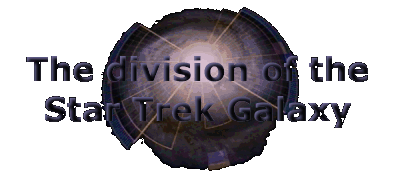
|
2.1.1 The subdivision of the Galaxy
While in our time, we haven't ventured deep enough into space to need other systems for the exact determination of positions within our incredibly large galaxy than the equatorial and galactic coordinate systems, in the world of Star Trek, in which the interstellar navigation is the basis of trade, politics and the everyday life of billions of people, a further subdivision of space is used, beside the much two large division into "galaxies" and the much two small division into "planetary systems" - the subdivision into quadrants and sectors. These two terms, whose meaning was quite contradictious at the beginning, but has been exactly fixed in the meantime, have become a basic element of the space navigation shown in Star Trek through the years, since with the sector and quadrant system, a certain place can be quite precisely localized, without using a complicated coordinate system.
1. The four quadrants
Already in the era of
Classic Trek, the expression "quadrant" was used for the exact determination of
positions in the Star Trek universe. However, this cartographic term which literally
refers to "a quarter" was used for completely different three-dimensional
volumes at that time:
sometimes a quadrant indeed corresponded to a quarter of the galaxy, but all too often it
also denoted considerably smaller regions. In this connotation, the size of a quadrant
rather corresponded to the size of a sector, like the designation "quadrant 904"
in [TOS] The Squire of Gothos indicates. Up to the beginning of The Next
Generation and also in the first movies the "quadrant" wasn't defined
unambiguously and was used contradictorily. Finally in Star Trek VI, the current - and
correct - quadrant system was introduced, according to which "the galaxy is
subdivided into 4 quadrants, from which each forms a 90 degrees piece of cake, viewing the
galaxy from the top or the bottom" (Star Trek Encyclopedia). An insider information
on this movie even implies that the system was mainly introduced to justify Captain Sulu's
claim that "he is in the Beta quadrant and currently the only Star Fleet ship in the
quadrant."
| An interesting
irregularity is the unusual designation system of the quadrants. They are arranged
neither clockwise nor counter-clockwise. Instead, the lower left quadrant is called
"Alpha", the lower right one "Beta", the upper left one
"Gamma" and the upper right one "Delta". It is unknown whether this
was originally a mistake that wasn't corrected afterwards to keep continuity or if it was
dramatic intention to degrade the quadrant of the classic empires of the Romulans and
Klingons to a "secondary quadrant" (after all, the Federation is supposed to be
mainly located in the Alpha Quadrant!). Unfortunately, in the last years it has become obvious that the script authors more and more disregard the quadrant system, which is still valid according to all recent official publications. At the beginning, this problem mainly concerned awkward, but individual errors by the authors, who simply mixed up Alpha and Beta Quadrant ([VOY] Message in a Bottle) and therefore mistakenly indicated a counter-clockwise quadrant arrangement, but now, in ST:DS9 as well as in ST:VOY, the Beta Quadrant is completely ignored, which is fatal especially concerning the Klingons and the Borg, which originally had nothing to with the Alpha Quadrant. |
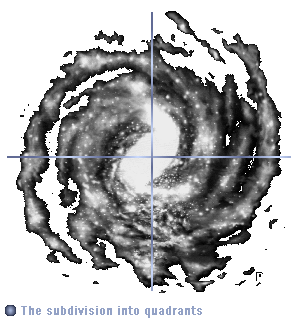 |
||||||||||||||||
On the basis of the diameter of the Milky Way and the number and situation of the quadrants to each other, we can now determine their dimensions: a quadrant has a width of 50000 ly (at the middle dividing line) and the same length (at the middle line as well). This is an inconceivable figure, even for the space travel in the 24th century (what is unfortunately often disregarded by the authors), how some velocity calculations prove:
|
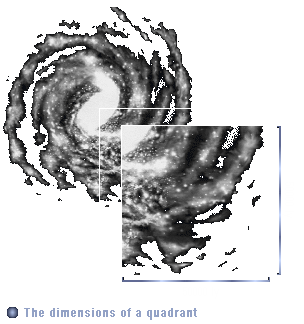 |
||||||||||||||||
Even a subspace transmission (warp 9.9999 with amplification) covers this distance in more than three months. Consequently, only the fact that Earth, the Federation and most of the other empires are located at the frontier between Alpha and Beta quadrant makes it possible that we hear something about other quadrants at all, and it isn't surprising that the two remaining quadrants - Gamma and Delta - were not explored until the era of DS9 and Voyager started, and then only with "tricks" like wormholes and intergalactic displacement waves.
2. The sectors
In contrast to the quadrants, space sectors, that are mentioned in nearly every episode (remember sector 001 - the solar system), are an astronomically small division of the galaxy and therefore more useful for the exact determination of positions in Star Fleet's everyday life - what explains their often use (although, however, in the recent seasons of Voyager and DS9 the Alpha Quadrant was mentioned in every second episode). Because the dimensions of a sector are, in contrast to the quadrants, not important for the episodes and this subdivision was always used for space regions of small scale, it isn't astonishing that the official definition was not determined "first hand" in a episode or movie (not even as background information), but in an official documentation.
According to the
pretty general definition of the Star Trek Encyclopedia, a sector is a space region with a
diameter of 20 ly, although some official maps further specify a sector in the
three-dimensional space as a cubic volume. By using its diameter, we can exactly calculate
the needed time for travelling through a sector at different warp factors, which shows
that for warp civilizations, a sector is a quantity they can easily manage within days.
However, at impulse speed, a sector is as insurmountable as a quadrant, since instead of
days, now tens of thousands of years are necessary for the travel.
|
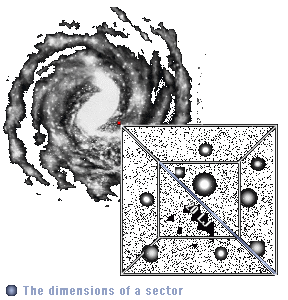 |
||||||||||||||||
Just as the quadrants, also the sectors have some irregularities in their designation, but that's acceptable in this case, because of the sector numbering system of the Federation, we only know the starting point (sector 001), but not the direction of the numbering, and the situation of the numbered sectors introduced in different episodes towards each other is unknown. However, it is very likely that in view of the centuries of space exploration and already different designation systems today, the system of the Federation is contradictious itself and the sectors are numbered more or less arbitrarily. It is also possible that the sector numbers, like the registry numbers, were assigned to newly discovered space regions at entirely different locations in space with increasing sequence, and the sector system accordingly has a chronological order.
| With the given numbers, however, we can nevertheless assume that at least larger space regions consist of systematically numbered sectors. For sectors near the Romulan Neutral Zone in the Beta Quadrant, which were crossed by 2150 for the first time, TOS used sector numbers with two digits, e.g. Sector 23, 30 and 31. The almost one century later surveyed sectors near the Klingon Empire, on the other hand, have 4-digit numbers, like Sector 2520. It is then very logical that sectors near the Cardassian Union and Talarian space, that were not discovered by the Federation until the beginning of the 24th century, carry 5-digit numbers, e.g. Sector 21503 and 21947. The position of sectors in the range of 100 till 1000 (e.g. sector 441) is unknown, however, they are probably located in the Southern Alpha Quadrant as well, but nearer to the center of the Federation. | 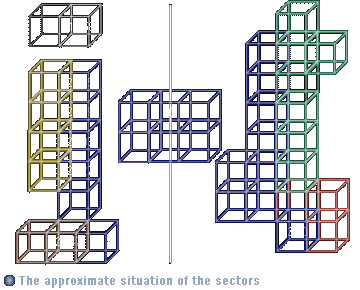 |
The Star Trek Encyclopedia suggests that "some sectors kept their old designations from earlier cartographing systems the same way as we use today both the older Messier and the newer NGC numbering system." In fact, some sectors apparently haven't a number at all (like the Igo Sector and the Bajoran Sector); they were named after the dominating planetary system or most important star in the sector.
2.1.2 The political division of the Galaxy
| Beside the strictly
scientific subdivision of the Galaxy, for the everyday life in the 24th century - as well
as today - especially the political subdivision of the Milky Way is important. However,
the appearance of a political map of the Milky Way considerably differs from a normal
geographical map, because such a inconceivably vast region like our Galaxy can surely not
be compared with the surface of a planet. Basically, in our Galaxy there is only a fistful of sufficiently large interstellar empires that take up more than one pixel in a map at all and can therefore be drawn in. Due to their low number and their distribution in the whole Milky Way, most of the area of a map of the Star Trek Galaxy remains blank - unexplored or neutral space, in which the local peoples inhabit only few planets, but not larger regions of hundreds of light years. |
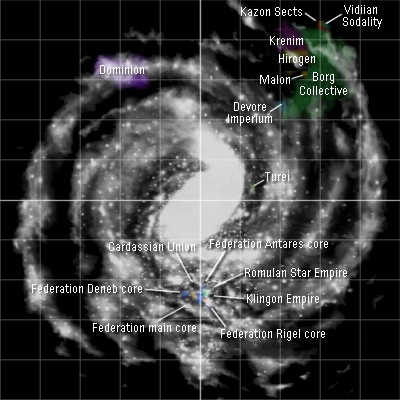 |
Already the mere space
explored by humanity - about 5000 ly on both sides of the Alpha/Beta Quadrant border, at
which Earth is located, there are six closely adjoined interstellar alliances and empires
- Federation, Romulan Star Empire, Klingon Empire, Cardassian Union, Breen Confederacy,
the Tholian Assembly and a dozen other important powers such as the Ferengi, Trill,
Talarians, Tzenkethi and Gorn. However, actually solely the United Federation of Planets
with 150+ member planets, numerous Federation protectorates and hundreds of colonized
planets, which are scattered over 8000 ly and distributed to several agglomeration areas
("cores"), is large enough to be visible on an overview map without exaggerated
dimensions.
Beside the Federation, the sole super power in the (known) lower part of the Milky Way,
however, there are more comparably large or even larger powers in the upper half: the
Dominion in the Gamma Quadrant, which takes up a whole part of the Sagittarius arm of the
Milky Way, and the Borg Collective, which core region has a perhaps five times as large
volume than the Federation has, but whose sphere of influence extends over the half Delta
and Beta Quadrant.
There are still other powers in the Galaxy, but which do not owe their large territories
to their political status (like the Federation as a loose, not necessarily spatially
joined interplanetary alliance) or their superiority to other species in numbers or
technology (like the Borg or the Dominion), but to other factors, which effect the
extension of their empires. For example, the Krenim belong(ed) to the dominating super
powers in the Delta Quadrant with almost a thousand planetary systems solely due to
alterations of the time line, which enlarged their empire and finally made it smaller
again. On the other hand, the Hirogen dominate a larger area of space despite their slow
ships because of the nomadic way of life which is typical for them - they restlessly
travel around to hunt their prey. The Turei inhabit a larger part of the lower Delta
Quadrant, because they have access to the sophisticated subspace corridor system of the
Vaadwaur. In the end, most peoples have too little influence on other empires or a too
less established territory to be called a super power, so that the number of interstellar
important alliances is very limited.
Finally, the exact political subdivision of the Galaxy remains unknown, because our
knowledge is sketchy at best. Only some small parts of the Alpha, Beta and Delta quadrants
are known, in which nonetheless the territories of more than a dozen powers are located.
The Gamma Quadrant could be explored merely four years, until the Dominion - the sole
power known in this quadrant - prevented this. Consequently, there is enough space in the
Milky Way for hundreds of interstellar alliances and empires, which could be discovered
already with the next deep space mission - the Cytherians, which apparently populate a
huge part of the galactic center, are only one example.
| The known political space regions of the Galaxy | |||
| Super powers I (Territory >10000 ly, Influence over several quadrants) | Super powers II (Territory several 1000 ly, very large influence) | Big powers (Territory few thousand ly, large influence) | Powers (Territory several hundred ly, medium influence) |
| Borg (Delta and Beta) | Federation (Alpha/Beta) | Cardassian Union (Alpha, as of Dominion membership) | Tholian Assembly (Beta)? |
| Dominion (Gamma and Alpha) | Krenim (Delta, one possible time line) | Klingon Empire (Beta) | Breen Confederacy (Alpha)? |
| Romulan Star Empire (Beta) | Kazon Sects (Delta) | ||
| Krenim (Delta, another possible time line) | Vidiian Sodality (Delta) | ||
| Hirogen (Delta) | |||
| Devore Imperium (Delta) | |||
| Turei (Delta) | |||
| Krenim (Delta, current time line?) | |||
After this summarizing introduction in the general subdivision of the Milky Way and the political situation in the Galaxy, now the time has come to immerse in the Star Trek Galaxy and to examine the most important planetary alliances and empires, their location, structure, formation and development more elaborately, starting with the United Federation of Planets.
� 1999-2001 by Star Trek Dimension / Webmaster. Last update: April 27th, 2000